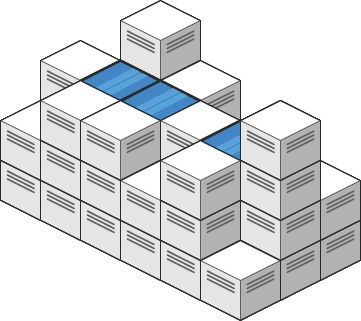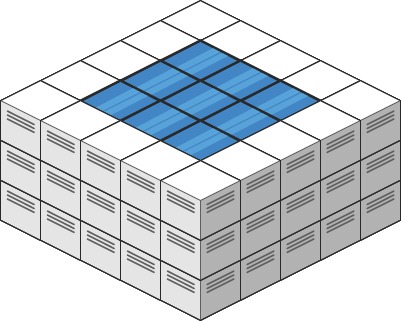- {x}
- Evaluate Division
- Nth Digit
- Binary Watch
- Remove K Digits
- Frog Jump
- Sum of Left Leaves
- Convert a Number to Hexadecimal
- Queue Reconstruction by Height
- Trapping Rain Water II
- Valid Word Abbreviation
- Longest Palindrome
- Split Array Largest Sum
- Minimum Unique Word Abbreviation
- Fizz Buzz
- Arithmetic Slices
- Third Maximum Number
- Add Strings
- Read More...

Trapping Rain Water II
Given an m x n integer matrix heightMap representing the height of each unit cell in a 2D elevation map, return the volume of water it can trap after raining.
Example 1:

Input: heightMap = [[1,4,3,1,3,2],[3,2,1,3,2,4],[2,3,3,2,3,1]] Output: 4 Explanation: After the rain, water is trapped between the blocks. We have two small ponds 1 and 3 units trapped. The total volume of water trapped is 4.
Example 2:

Input: heightMap = [[3,3,3,3,3],[3,2,2,2,3],[3,2,1,2,3],[3,2,2,2,3],[3,3,3,3,3]] Output: 10
Constraints:
m == heightMap.lengthn == heightMap[i].length1 <= m, n <= 2000 <= heightMap[i][j] <= 2 * 104
Solution Explanation: Trapping Rain Water II
This problem asks to find the volume of rainwater trapped in a 2D elevation map. The key idea is to use a priority queue (min-heap) to process cells in increasing order of height, ensuring that we always consider cells with lower heights first, mimicking the water filling process.
Algorithm:
-
Initialization:
- Create a boolean matrix
visto track visited cells (initially all false). - Create a min-heap
pqto store cells. Initially, add all boundary cells topqwith their heights as priorities. Mark these boundary cells as visited invis.
- Create a boolean matrix
-
Iteration:
- While the priority queue is not empty:
- Pop the cell with the minimum height from
pq(let's call it(i, j)with heighth). - For each unvisited neighbor
(x, y)of(i, j):- Calculate the water trapped at
(x, y):max(0, h - heightMap[x][y]). Add this to the total trapped waterans. - Mark
(x, y)as visited (vis[x][y] = True). - Push
(x, y)intopqwith a priority ofmax(h, heightMap[x][y]). This ensures that the next time we process a neighbor, its height (or the height of its higher neighbor) is used for determining the trapped water.
- Calculate the water trapped at
- Pop the cell with the minimum height from
- While the priority queue is not empty:
-
Return: Return the total trapped water
ans.
Time Complexity Analysis:
- Each cell is added to and removed from the priority queue at most once.
- The priority queue operations (insertion and deletion) take O(log(M*N)) time, where M and N are the dimensions of the matrix.
- The total number of cells is M*N.
- Therefore, the overall time complexity is O(MN log(MN)).
Space Complexity Analysis:
- We use a boolean matrix
visof size MN to keep track of visited cells, O(MN). - The priority queue can, in the worst case, contain all cells (MN), so its space complexity is O(MN).
- Therefore, the overall space complexity is O(M*N).
Code in Different Languages:
The provided code snippets (Python, Java, C++, Go) follow the algorithm described above. They use a min-heap (priority queue) data structure to efficiently process cells in ascending order of height. The dirs array helps to efficiently iterate over the four neighboring cells of a given cell. The use of vis ensures we don't process the same cell multiple times, preventing infinite loops. The Go code also demonstrates the implementation of a min-heap using a custom type and the heap package. The choice of language impacts the syntax but the core algorithm remains the same.